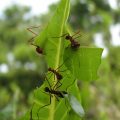Since 2005 when biologist Stephen Yanoviak and his colleagues first reported that a species of tree-nesting tropical ant Cephalotes atratus, can glide backwards in a directed flight, the scientists have been studying this and other species of ants dropped from high places in Africa, Peru, Panama, Costa Rica and the United States. Seeking answers to the questions their 2005 discovery raised about the origin and evolution of flight in wingless ants, the researchers have used ropes, canopy walkways, construction towers, video cameras and even wind tunnels to conduct research on this previously unknown behavior in ants.
This short video shows frame-by-frame views of the movements of an ant (Cephalotes atratus) suspended in the updraft of a wind tunnel chamber. The three images are from above and two sides, and all are synched. These tree-dwelling ants are capable of a directed aerial descent (DAD) should they fall from high-up in the tree canopy. DAD is a defensive behavior that allows an ant to glide backwards and steer itself toward and land on the trunk of the tree from which it fell. In this way it is saved from the distant, hostile and unfamiliar terrain of the forest floor. (Video credit Yonatan Munk, UC Berkeley.)
Directed aerial descent (DAD) is a defensive behavior that allows an ant dislodged from the tree canopy to glide toward and land back on the trunk of the tree from which it fell. In this way it is saved from the distant, hostile and unfamiliar terrain of the forest floor.
This video was created to compare a non-gliding and a gliding ant, both dropped from a tree. Videos courtesy of Steve Yanoviak.
One of the most challenging aspects of this research is simply studying these insects as they are falling, says Yanoviak, a tropical arthropod ecologist at the University of Arkansas, Little Rock, and colleagues, Robert Dudley of the Smithsonian Tropical Research Institute, and Yonatan Munk, University of California, Berkeley. Small body size, rapid descent, and the long distances that they can fall, make accurate data taking a challenge, they write in a recent paper published in the journal of Integrative and Comparative Biology summarizing their research.
Still, the team has discovered many new and interesting aspects to the directed aerial descent of different species of ants:
- DAD has multiple evolutionary origins in ants, the researchers say, occurring independently in numerous genera in the subfamilies Myrmicinae, Formicinae and Pseudomyrmecinae.
- Wind tunnel videos reveal that as they fall, gliding C. atratus ants hold their legs elevated and outstretched above the main body, and their gaster (the bulbous posterior body segment) fixed slightly below the main body axis. This configuration is aerodynamically stable and creates a force that pushes the ant backwards in a controlled glide. These ants steer by changing the position of their hind legs, mid legs and gaster.
- Ants with hind legs, mid legs and gaster removed are unable to steer or glide effectively.
- Only tree-nesting ant species are capable of directed aerial descent. Some species are capable of righting themselves as they fall and rotating so their heads point toward the trunk of the tree from which they fell, but are not capable of horizontal movement. This suggests a transitional period in which these ants are evolving a gliding behavior.
- Ground nesting ant species may forage in the tree canopy but they cannot glide.
- Morphologically, ant species that can glide look no different from ant species that cannot.
- Gliding ants that are active both day and night, cannot glide at night, mainly due to their inability to see a target in the darkness.
- Gliding ants that fall into the leaf litter or into water are frequently attacked and killed by other ants, insects and fish. The mortality of ants that fall to the forest floor varies depending on environment.
Given the wide diversity of arboreal ants in the world, the researchers say, a broader study of directed aerial descent in these social insects promises a deeper understanding of the origin and evolution of this unusual behavior.







